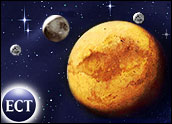
School children will have to take the “P” out of whatever mnemonic they use to help them remember the solar system’s planet lineup. That’s because astronomers decided on Thursday to nix Pluto from the group of nine planets under historic new guidelines that downsize the solar system.
The International Astronomical Union withdrew Pluto’s planetary status in a true clash of the cosmos that came in the form of a week-long debate. Pluto has been considered a planet since 1930.
Three new planetary contenders were introduced into the debate that also didn’t make the cut: Ceres, Charon and 2003 UB313, currently nicknamed “Xena.”
Rise of the Dwarfs
New rules outlined by the group this week define a planet as “a celestial body that is in orbit around the sun, has sufficient mass for its self-gravity to overcome rigid body forces so that it assumes a … nearly round shape, and has cleared the neighborhood around its orbit.”
Pluto was disqualified because its oblong orbit overlaps with Neptune’s. Mercury, Venus, Earth, Mars, Jupiter, Saturn, Uranus and Neptune remain planets under the group’s standards.
Pluto has been officially designated a “dwarf planet,” similar to what the astronomers have called “minor planets.” The new definition also makes room for a third class of lesser objects that orbit the sun called “small solar system bodies.” These include asteroids, comets and other natural satellites.
Marketing Controversy
The 2,500 astronomers from 75 countries are split over the controversial decision, and the sometimes-hostile debates between groups that took a stand for or against Pluto have not ended.
Now, marketers and educational companies are staking stands of their own. Some have asserted that Pluto’s demise is based on a desire on the part of publishers to sell more textbooks.
“The International Astronomical Union decides on the gold standard in naming heavenly bodies. I am sure there will be people who say this is foolish and arbitrary, but the astronomers know better than us why they are doing this,” Carl Benoit, Learning Resources editorial director and former national science consultant, told TechNewsWorld.
Even though it means revamping several solar system products, Learning Resources likes the idea of reshaping the solar system.
“Anything that sparks excitement about science, math, and technology in U.S. children is tremendous,” Benoit said. “We need more students to think about a career in these important subjects and today’s proposed addition of new planets to the solar system will have children and their parents and teachers talking about space science as the school year begins.”
Strengthening America’s Education
Indeed, recent studies have shown that America’s science and math education efforts could use some help. A Raytheon survey of 1,000 11-to-13-year-olds released in January found that 84 percent said they would “rather clean their room, eat their vegetables, go to the dentist or take out the garbage than learn math or science.”
That distaste for math and science could be why U.S. 12th-graders recently tested below the international average in those subjects. About one-third of the fourth-graders and one-fifth of the eighth-graders cannot perform “basic mathematical computations,” according to the National Center for Education Statistics.





















































